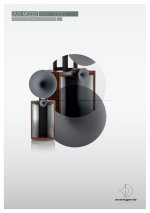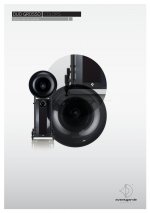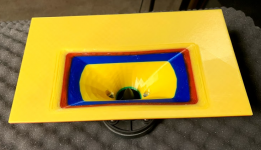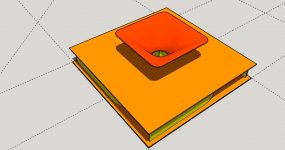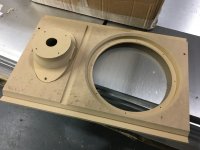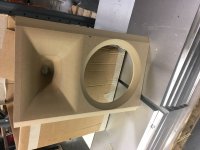This was not about absorptive walls but about edges on a hard wall. So how will edges on otherwise hard and reflective surface help for better guidance? I did some experiments with added wall "edginess" in simulations but it was never any better than a smooth surface so I would just like to see some counterexample.
Did you ever compare 2 identical waveguides, one with a smooth, glossy finish and one with a Nextel coating?
I can tell from experience the first speaker sounds considerably better than the scond one.
But that's still no hard evidence based on data, of course.
I can tell from experience the first speaker sounds considerably better than the scond one.
But that's still no hard evidence based on data, of course.
Attachments
Last edited:
"Our cabinets are now coated with the patented material known as Nextel©. It's a matte textured coating that absorbs light and sound. It reduces cabinet diffraction effects and absorbs surface vibrations for a more silent cabinet."
There's a lot of research available wrt Nextel by NASA ea. Admittedly, it's primarily focussed on reflection and absorbtion of light/heat.
Quote from another forum:
"christensenleif said:
another conclusion I´ve come to, is that a Nextel coated horn sounds smoother than a glossy piano finish
getting associations to the dimples in golf balls
mentioned this to Rune Skramstad, Bjørn Kolbræks doctorate tutor, and they wanted to calculate on it.......
beyond my math level....
actually one of the other guys who got the alu 2500 for the 2002 had it painted in Nextel
would be cool to compare....
Maybe it helps to minimize the high order modes (HOMs) that led Earl Geddes to put foam plugs in his oblate spheroid horn/waveguides?
Industry Affiliation:
Sound Castles klg
Swiss Importer/distributor for Aries Cerat Ltd."
Though I prefer not to, I'm willing to accept some acoustic phenomena are very hard to quantify of not (yet) measurable.
There's a lot of research available wrt Nextel by NASA ea. Admittedly, it's primarily focussed on reflection and absorbtion of light/heat.
Quote from another forum:
"christensenleif said:
another conclusion I´ve come to, is that a Nextel coated horn sounds smoother than a glossy piano finish
getting associations to the dimples in golf balls
mentioned this to Rune Skramstad, Bjørn Kolbræks doctorate tutor, and they wanted to calculate on it.......
beyond my math level....
actually one of the other guys who got the alu 2500 for the 2002 had it painted in Nextel
would be cool to compare....
Maybe it helps to minimize the high order modes (HOMs) that led Earl Geddes to put foam plugs in his oblate spheroid horn/waveguides?
Industry Affiliation:
Sound Castles klg
Swiss Importer/distributor for Aries Cerat Ltd."
Though I prefer not to, I'm willing to accept some acoustic phenomena are very hard to quantify of not (yet) measurable.
Last edited:
isn't the inside surface tension of the wave guide or horn a matter of weather or not you want to generate drag (friction due to turbulence/resistance) on the outside edge of the wavefront as it leaves the mouth? for example a smooth surface will help to keep the exiting wavefront flat while a rough surface will result in adding some drag to the outside edges of the wavefront making for some curvature all be it a very small amount?
while a rough surface will result in adding some drag to the outside edges of the wavefront making for some curvature all be it a very small amount?
i've extracted this portion of your statement as i feel this is a salient point!
could this not give rise to a means to control the off axis response?
to wit diffraction is not per se evil and can be used to good effect if controlled/tailored to achieve a specific result, no?
Hi, Mabat. Thank you so much for sharing your excellent work. Being much less mathematical myself, i was wondering if you could help me out with one of your equations.
Im sketching in Inventor, using the equation curve tool. Is it possible to arrange an equation with the mouth dimension as an input and the depth as a free variable?
Too me, the most significant difference between the clotoid/super-ellipse seems to be the user friendliness and perhaps the greater flexibility of the SE-equation, so whatever is the simplest to work with is preferred.
Im sketching in Inventor, using the equation curve tool. Is it possible to arrange an equation with the mouth dimension as an input and the depth as a free variable?
Too me, the most significant difference between the clotoid/super-ellipse seems to be the user friendliness and perhaps the greater flexibility of the SE-equation, so whatever is the simplest to work with is preferred.
You weren't kidding.The math gets ugly very quickly
The program works perfect, thank you very much.
I've been planning to build a Cornu baffle for a few weeks, I've always imagined it with a horn, looking for information I found your program, now comes the most fun, learn and experience, your program is the tool.
I am new to the forum and I ask is there any exclusive thread of Horn's design? I have some questions and a lot to learn.
Thanks again.
Roberto
I've been planning to build a Cornu baffle for a few weeks, I've always imagined it with a horn, looking for information I found your program, now comes the most fun, learn and experience, your program is the tool.
I am new to the forum and I ask is there any exclusive thread of Horn's design? I have some questions and a lot to learn.
Thanks again.
Roberto
Attachments
There is a tremendous amount of valuable information regarding system design with horns here on diyAudio, unfortunately so scattered around that it is hard to recommend any specific thread. There was a time when Earl Geddes contributed here very actively, see "Geddes on Waveguides" for one, although such long and diverse threads may be tedious to read afterwards. For getting a good grasp it is still invaluable.
One thing I can tell you from my limited experience: Just test the horn with BEM/ABEC and if the result looks good, it will perform very well in real.
One thing I can tell you from my limited experience: Just test the horn with BEM/ABEC and if the result looks good, it will perform very well in real.
Last edited:
The program works perfect, thank you very much.
I've been planning to build a Cornu baffle for a few weeks, I've always imagined it with a horn, looking for information I found your program, now comes the most fun, learn and experience, your program is the tool.
I am new to the forum and I ask is there any exclusive thread of Horn's design? I have some questions and a lot to learn.
Thanks again.
Roberto
This books good:
High Quality Horn Loudspeaker Systems by Bjørn Kolbrek and Thomas Dunker
bed time reading for months!
For what purpose - what would you want to achieve?
I wondered if it were possible to parametize out a smoother response to the output of the driver.
Ro808: I'd need to see some data on what you are talking about. To state "It's widely known" is not enough for me. So many things that are "widely known" are also plainly false...
I agree.
It is not known what effect the wall texture has on a horn. I would surmise that in any case, it is minimal.
The normal mode will barely see any wall texture since its wave is propagating at a grazing incidence, which "is widely known" that this means little to no effect on the wave. This is certainly true if the texture is small compared to a wavelength. Hence for this mode virtually nothing happens.
For higher order modes there might be a small loss and dispersion of the wave, but nothing even remotely comparable to the use of foam.
I had long considered the wall texture and concluded that it's effect would be so small as to be not worth the trouble. Certainly when foam is used it is not going to be even a small effect.
As to it's audibility, I'd put it down to the same effect as huge speaker cables - an effect that has ever been shown to be audible in a controlled test.
Last edited:
Modelled well - testing tomorrow! Thanks mabat for an amazing tool!
Target : HF146 & 12P80ND
Target : HF146 & 12P80ND
Attachments
Last edited:
Modelled well - testing tomorrow! Thanks mabat for an amazing tool!
Target : HF146 & 12P80ND
I really need to assemble my CNC 😭
Would you mind showing the simulation results? Why two-part?Modelled well - testing tomorrow!
- Home
- Loudspeakers
- Multi-Way
- Acoustic Horn Design – The Easy Way (Ath4)
